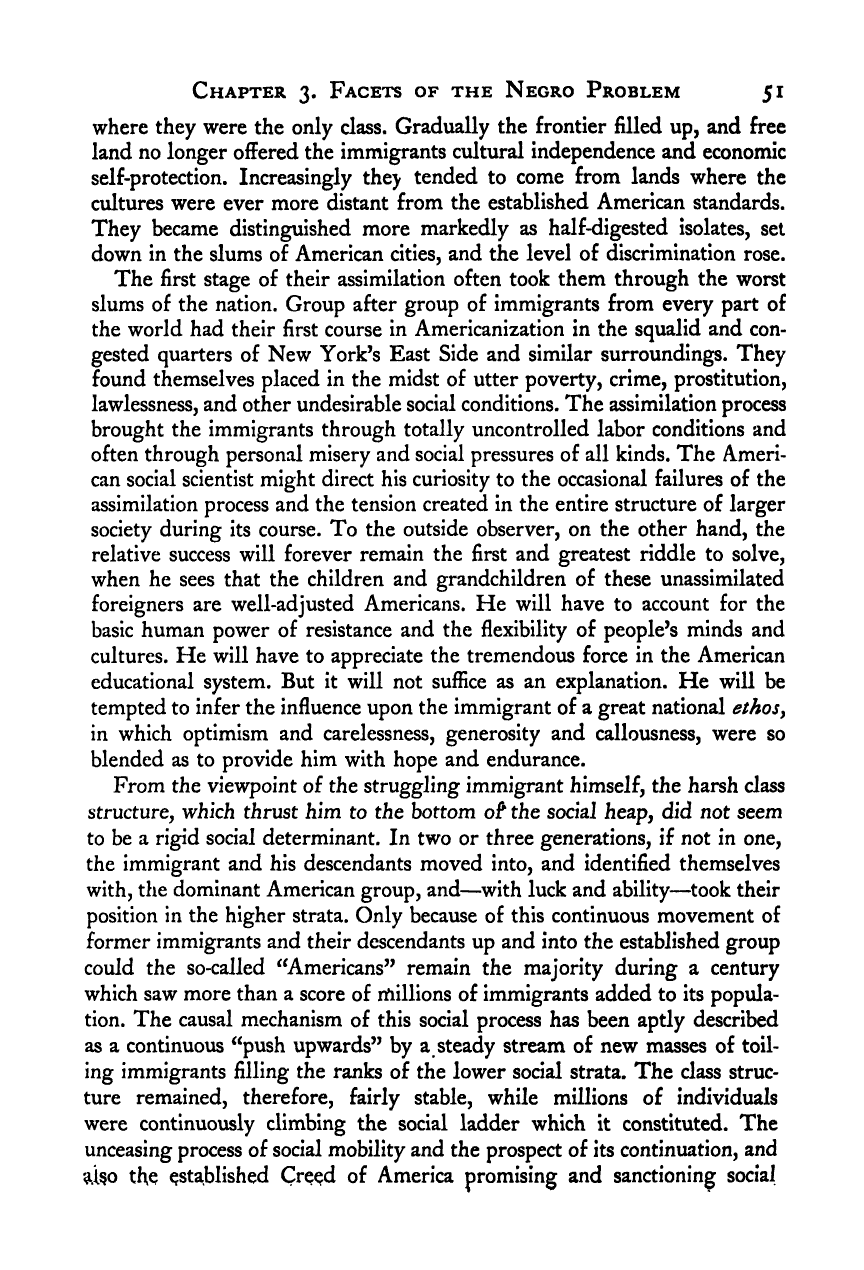Note: Gunnar Myrdal died in 1987, less than 70 years ago. Therefore, this work is protected by copyright, restricting your legal rights to reproduce it. However, you are welcome to view it on screen, as you do now. Read more about copyright.
Full resolution (TIFF) - On this page / på denna sida - I. The Approach - 3. Facets of the Negro Problem - 1. American Minority Problems

<< prev. page << föreg. sida << >> nästa sida >> next page >>
Below is the raw OCR text
from the above scanned image.
Do you see an error? Proofread the page now!
Här nedan syns maskintolkade texten från faksimilbilden ovan.
Ser du något fel? Korrekturläs sidan nu!
This page has never been proofread. / Denna sida har aldrig korrekturlästs.
Chapter 3. Facets of the Negro Problem 51
where they were the only class. Gradually the frontier filled up, and free
land no longer offered the immigrants cultural independence and economic
self-protection. Increasingly they tended to come from lands where the
cultures were ever more distant from the established American standards.
They became distinguished more markedly as half-digested isolates, set
down in the slums of American cities, and the level of discrimination rose.
The first stage of their assimilation often took them through the worst
slums of the nation. Group after group of immigrants from every part of
the world had their first course in Americanization in the squalid and con-
gested quarters of New York’s East Side and similar surroundings. They
found themselves placed in the midst of utter poverty, crime, prostitution,
lawlessness, and other undesirable social conditions. The assimilation process
brought the immigrants through totally uncontrolled labor conditions and
often through personal misery and social pressures of all kinds. The Ameri-
can social scientist might direct his curiosity to the occasional failures of the
assimilation process and the tension created in the entire structure of larger
society during its course. To the outside observer, on the other hand, the
relative success will forever remain the first and greatest riddle to solve,
when he sees that the children and grandchildren of these unassimilated
foreigners are well-adjusted Americans. He will have to account for the
basic human power of resistance and the flexibility of people’s minds and
cultures. He will have to appreciate the tremendous force in the American
educational system. But it will not suffice as an explanation. He will be
tempted to infer the influence upon the immigrant of a great national ethos
in which optimism and carelessness, generosity and callousness, were so
blended as to provide him with hope and endurance.
From the viewpoint of the struggling immigrant himself, the harsh class
structure, which thrust him to the bottom of the social heap, did not seem
to be a rigid social determinant. In two or three generations, if not in one,
the immigrant and his descendants moved into, and identified themselves
with, the dominant American group, and—with luck and ability—took their
position in the higher strata. Only because of this continuous movement of
former immigrants and their descendants up and into the established group
could the so-called ^^Americans” remain the majority during a century
which saw more than a score of rfiillions of immigrants added to its popula-
tion. The causal mechanism of this social process has been aptly described
as a continuous ^‘push upwards” by a steady stream of new masses of toil-
ing immigrants filling the ranks of the lower social strata. The class struc-
ture remained, therefore, fairly stable, while millions of individuals
were continuously climbing the social ladder which it constituted. The
unceasing process of social mobility and the prospect of its continuation, and
a.i^o the established Creed of America promising and sanctioning social
<< prev. page << föreg. sida << >> nästa sida >> next page >>